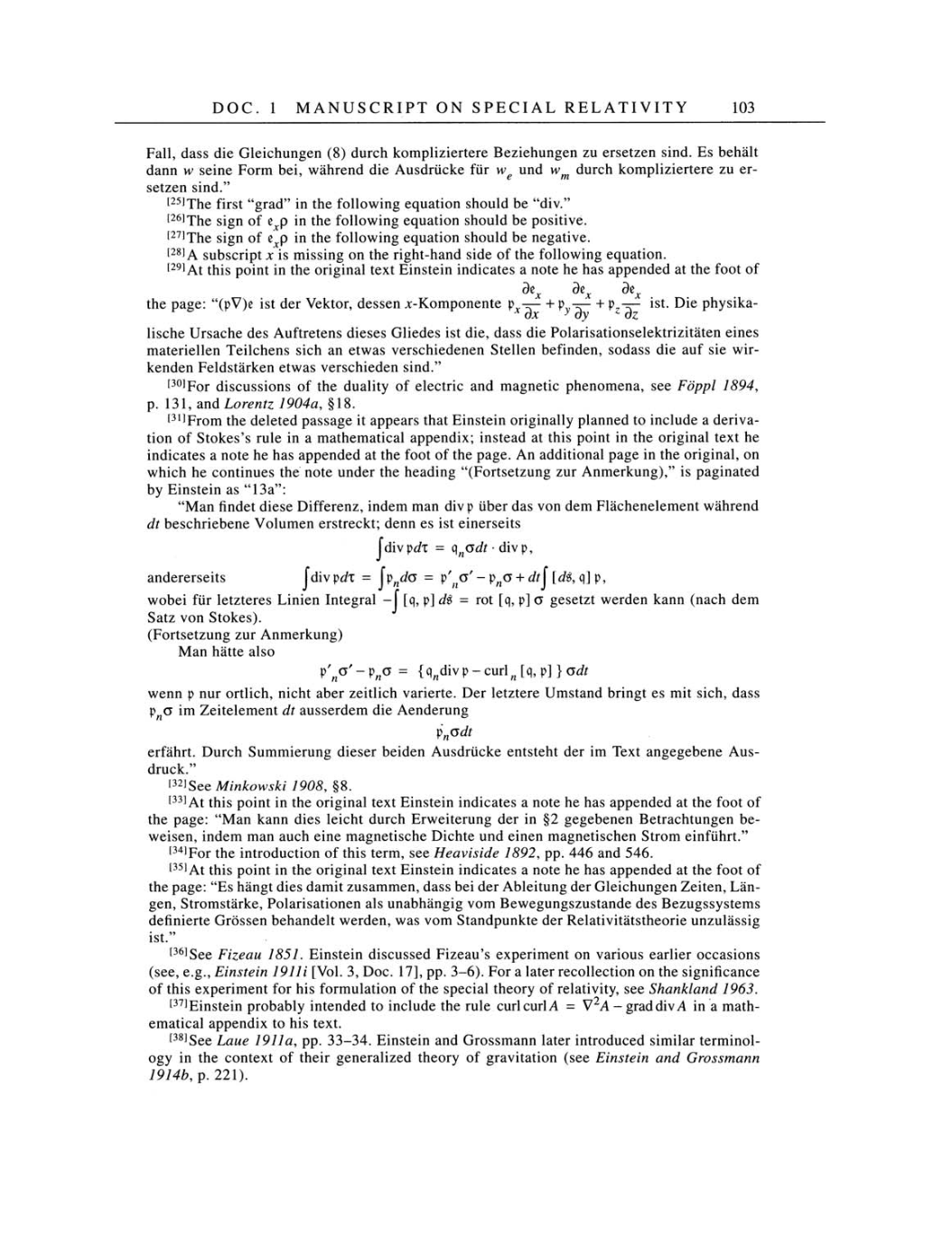DOC.
1
MANUSCRIPT
ON SPECIAL
RELATIVITY
103
Fall, dass
die
Gleichungen (8)
durch
kompliziertere Beziehungen
zu
ersetzen
sind.
Es
behält
dann
w
seine Form
bei,
während die Ausdrücke für
we
und
wm
durch
kompliziertere
zu er-
setzen
sind."
[25]The
first
"grad"
in
the
following equation
should
be
"div."
[26]The sign
of
exp
in
the
following equation
should
be
positive.
[27]The sign
of
exp
in
the
following equation
should
be negative.
[28]A
subscript
x
is
missing
on
the
right-hand
side of the
following equation.
[29]At this
point
in
the
original text
Einstein
indicates
a
note
he
has
appended at
the foot of
the
page: "(pV)e
ist der
Vektor,
dessen
x-Komponente
pxdex/dx
+
pydex/dy
+
Pzdex/dz
ist.
Die
physika-
lische Ursache des Auftretens dieses Gliedes ist
die,
dass die Polarisationselektrizitäten
eines
materiellen Teilchens sich
an
etwas
verschiedenen Stellen
befinden,
sodass
die
auf sie wir-
kenden Feldstärken
etwas
verschieden sind."
[30]For
discussions of the
duality
of electric
and
magnetic phenomena,
see
Föppl
1894,
p.
131,
and
Lorentz 1904a,
§18.
[31]From
the deleted
passage
it
appears
that Einstein
originally planned to
include
a
deriva-
tion of Stokes's
rule
in
a
mathematical
appendix;
instead
at
this
point
in
the
original text
he
indicates
a
note
he
has
appended at
the foot of the
page.
An
additional
page
in
the
original,
on
which
he
continues the
note
under the
heading "(Fortsetzung
zur
Anmerkung),"
is
paginated
by
Einstein
as
"13a":
"Man findet diese
Differenz,
indem
man
div
p
über das
von
dem
Flächenelement während
dt
beschriebene
Volumen
erstreckt;
denn
es
ist
einerseits
Jdivp
dx
= c\nGdt
divp,
andererseits
Jdivp
dx
=
Jp"dG
=
p'nG'-vnG +
dtj[d$,c\\p,
wobei für letzteres Linien
Integral -J
[q, p]
d$
=
rot
[q,
p] G
gesetzt
werden kann
(nach dem
Satz
von
Stokes).
(Fortsetzung
zur
Anmerkung)
Man
hätte also
p'na'-p"G
=
{
q"div
p
-
curl
n
[q, p]
}
Gdt
wenn
p
nur
ortlich,
nicht aber zeitlich varierte. Der letztere Umstand
bringt
es
mit
sich, dass
pnG
im
Zeitelement dt ausserdem die
Aenderung
pnGdt
erfährt. Durch
Summierung
dieser beiden Ausdrücke entsteht der
im Text
angegebene
Aus-
druck."
[32]See
Minkowski
1908, §8.
[33]At this
point
in
the
original text
Einstein indicates
a
note
he has
appended at
the foot of
the
page:
"Man
kann dies leicht durch
Erweiterung
der
in
§2
gegebenen Betrachtungen
be-
weisen,
indem
man
auch eine
magnetische
Dichte und einen
magnetischen
Strom einführt."
[34]For
the introduction of this
term,
see
Heaviside
1892,
pp.
446 and 546.
[35]At this
point
in
the
original text
Einstein indicates
a
note
he
has
appended at
the
foot of
the
page:
"Es
hängt
dies damit
zusammen,
dass bei der
Ableitung
der
Gleichungen
Zeiten,
Län-
gen,
Stromstärke,
Polarisationen
als
unabhängig
vom
Bewegungszustande
des
Bezugssystems
definierte Grössen behandelt
werden,
was vom
Standpunkte
der Relativitätstheorie
unzulässig
ist."
[36]See
Fizeau 1851.
Einstein discussed Fizeau's
experiment
on
various earlier occasions
(see,
e.g.,
Einstein
1911i
[Vol. 3,
Doc.
17],
pp.
3-6).
For
a
later recollection
on
the
significance
of this
experiment
for his formulation of the
special theory
of
relativity,
see
Shankland
1963.
[37]Einstein
probably
intended
to
include the rule
curl curl
A
=
V2A
-
grad div
A
in
a
math-
ematical
appendix to
his
text.
[38]See
Laue
1911a,
pp.
33-34. Einstein
and
Grossmann later introduced similar terminol-
ogy
in
the
context
of their
generalized theory
of
gravitation (see
Einstein and
Grossmann
1914b,
p.
221).
